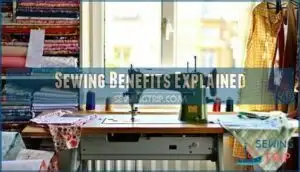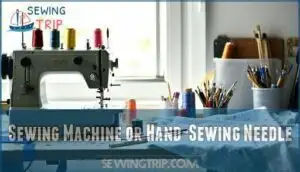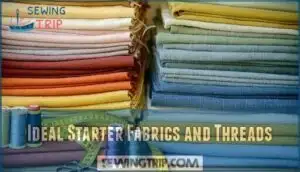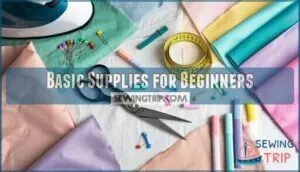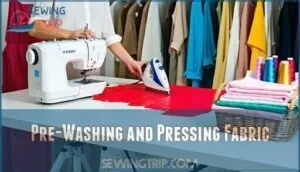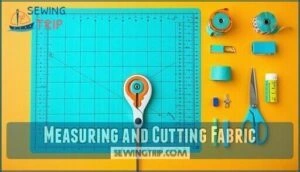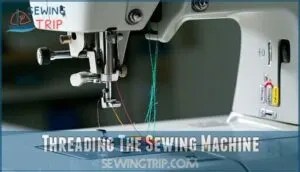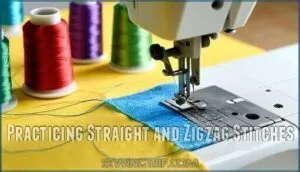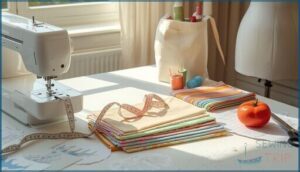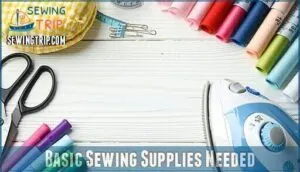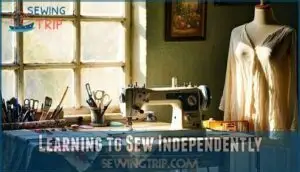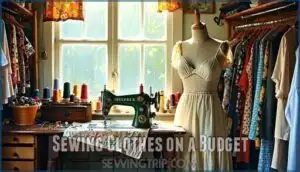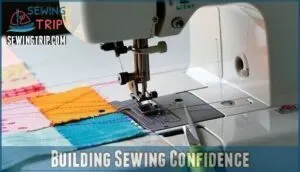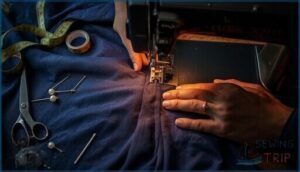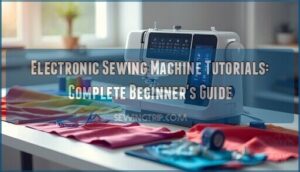This site is supported by our readers. We may earn a commission, at no cost to you, if you purchase through links.
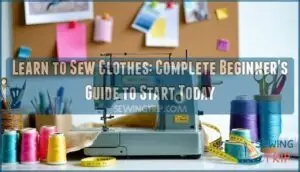 You can learn to sew clothes by starting with basic tools like a sewing machine, fabric scissors, and measuring tape.
You can learn to sew clothes by starting with basic tools like a sewing machine, fabric scissors, and measuring tape.
Begin with simple projects such as tote bags or basic skirts to build your confidence before tackling complex garments.
Choose beginner-friendly fabrics like cotton, and practice fundamental techniques including straight stitches and seam finishing.
Online tutorials and sewing communities offer excellent support as you progress.
The key is starting small – even seasoned sewists began with wonky stitches and crooked hems.
Remember, every expert was once a beginner who refused to give up, and the right foundation makes all the difference in your sewing journey.
Table Of Contents
- Key Takeaways
- Sewing Benefits Explained
- Essential Sewing Tools
- Mastering Sewing Techniques
- Beginner Sewing Projects
- Choosing The Right Sewing Machine
- Basic Sewing Supplies Needed
- Learning to Sew Independently
- Sewing Clothes on a Budget
- Building Sewing Confidence
- Advanced Sewing Techniques
- Frequently Asked Questions (FAQs)
- Conclusion
Key Takeaways
- Start with basic tools and simple projects – You don’t need expensive equipment to begin; grab a sewing machine, fabric scissors, measuring tape, and pins, then tackle beginner-friendly projects like tote bags or elastic-waist skirts to build your confidence before attempting complex garments.
- Choose beginner-friendly fabrics and practice fundamental techniques – You’ll have better success starting with cotton or cotton blends since they’re forgiving, and focus on mastering straight stitches, seam allowances, and proper fabric preparation before moving to advanced skills.
- Learn independently through free resources and community support – You can teach yourself using YouTube tutorials, online patterns, and sewing communities that provide guidance and troubleshooting help without needing formal classes or expensive instruction.
- Embrace mistakes as part of the learning process – You’ll make crooked seams and wonky stitches at first, but every expert started as a beginner; track your progress in a sewing journal and remember that each completed project builds the skills and confidence you need for more complex garments.
Sewing Benefits Explained
Learning to sew clothes opens up a world where you control every stitch, color, and style choice, turning your wardrobe into a personal canvas that reflects exactly who you are.
You’ll build practical skills that last a lifetime, gain confidence with each completed project, and discover a hobby that keeps challenging you in the best possible way.
Sewing transforms fabric into confidence, one stitch at a time—building skills that last forever.
Creative Control and Self-Expression
When you start sewing, you’re holding the keys to your own fashion kingdom.
No more settling for cookie-cutter clothes that don’t quite fit your vibe or body.
Here’s what creative sewing freedom gives you:
- Personalized Style – Create pieces that scream "you"
- Unique Designs – Stand out from mass-produced fashion
- Fabric Choices – Pick textures and colors you love
- DIY Fashion – Express yourself through every stitch
Sewing can also provide significant stress relief through its mindful, repetitive motions.
Building Confidence and Practical Skills
Through hands-on sewing practice, you’ll develop rock-solid confidence as each completed project proves your growing abilities.
Every stitch you complete builds the unshakeable confidence that transforms fabric into your personal fashion statement.
Mastering sewing basics like straight stitches and seam allowances builds practical skills you’ll use forever.
Every challenge you overcome strengthens your problem-solving muscles, while community support and learning resources guide your skill progression toward increasingly complex sewing techniques.
Lifelong Hobby and Continuous Learning
Through skill diversification and pattern adaptation, your sewing education becomes a lifelong journey of textile exploration.
The sewing hobby offers endless opportunities for community engagement and sewing evolution as your techniques mature.
- Master new sewing skills like embroidery, quilting, and tailoring
- Explore different fabrics from silk to denim for diverse projects
- Connect with online sewing communities for inspiration and support
- Adapt vintage patterns to create modern, personalized garments
Sense of Accomplishment and Pride
Beyond continuous learning, you’ll discover that finishing your first sewing project brings incredible satisfaction.
Project completion creates a rush of sewing pride that builds your self-esteem with each handmade gift you create.
Skill mastery through creative expression fuels personal growth, turning simple fabric into treasured garments that showcase your unique style and newfound sewing accomplishment.
| Project Type | Pride Level | Growth Impact |
|---|---|---|
| First seam | High satisfaction | Confidence boost |
| Complete garment | Deep fulfillment | Major milestone |
| Handmade gifts | Joy and sharing | Connection building |
| Pattern mastery | Technical pride | Skill advancement |
| Creative design | Personal expression | Artistic development |
Essential Sewing Tools
You’ll need a few basic tools to start your sewing journey, and the good news is that you don’t need to buy everything at once.
Start with a sewing machine or hand-sewing needle, sharp fabric scissors, measuring tape, pins, and an iron, then add more supplies as your skills grow and your projects become more complex.
Sewing Machine or Hand-Sewing Needle
When choosing between a sewing machine and hand-sewing needles, consider your project goals and budget.
Machine vs Hand sewing offers different benefits – machines deliver consistent stitch quality and speed for larger projects, while sewing needles provide portability and lower cost comparison.
For sewing for beginners, machines accelerate the learning curve, though both help you learn sewing techniques effectively.
Ideal Starter Fabrics and Threads
Once you’ve got your machine ready, picking the right fabric and thread makes all the difference. Start with 100% cotton or cotton blends – they’re forgiving and won’t slide around like silk.
Medium fabric weight works best for sewing beginners, while all-purpose polyester thread handles most projects. One can also begin with stable and forgiving flannel due to its forgiving nature.
- Cotton quilting fabric with tight weave density
- Sustainable fabrics like linen for easy handling
- Colorfast materials that won’t bleed when washed
Basic Supplies for Beginners
Your sewing kit needs sharp fabric scissors that cut cleanly through material.
Add measuring tools like a flexible tape measure for accurate sizing. Stock up on quality pins selection including straight pins and safety pins.
Grab marking implements such as fabric chalk or washable markers. Don’t forget ironing essentials – a good iron and pressing cloth.
These sewing supplies work together with your sewing machine to create professional results.
Mastering Sewing Techniques
Once you’ve gathered your tools, you’ll need to learn the core techniques that turn fabric into wearable clothes.
These fundamental skills include preparing your fabric properly, cutting accurately along pattern lines, and mastering your sewing machine’s basic stitches—think of them as the building blocks that’ll help you create garments that actually fit and look professional.
They are essential for creating garments that actually fit and look professional.
Pre-Washing and Pressing Fabric
Now that you’ve got your tools ready, proper fabric preparation sets the foundation for successful sewing projects.
Pre-washing your sewing fabric washing prevents shrinkage prevention and removes excess dye removal that could bleed onto other garments.
After sewing fabric drying, use your sewing iron for wrinkle removal and sewing fabric pressing to smooth the fabric grain.
- Shrinkage Prevention: Always pre-wash fabric before cutting to avoid disappointing size changes later
- Iron Temperature: Check fabric labels and adjust your sewing iron heat settings accordingly
- Wrinkle Removal: Press fabric completely smooth for accurate cutting and professional-looking results
Measuring and Cutting Fabric
Accurate measuring and fabric cutting form the backbone of successful sewing projects.
Start by understanding fabric grain – the direction threads run in your material. Use sharp cutting tools like fabric scissors or rotary cutters for clean edges.
When doing pattern layout, align pieces with the grainline arrows. Practice sewing measuring techniques and cutting curves on scraps first.
Threading The Sewing Machine
Once you’ve cut your fabric pieces, it’s time to thread your sewing machine. Don’t worry if it feels tricky at first – even experienced sewers sometimes need a refresher on threading order.
Here’s your step-by-step threading checklist:
- Follow your sewing machine user manual’s threading diagram carefully
- Wind the bobbin first, then insert it into the bobbin case
- Thread the top thread through all guides in proper threading order
- Check tension settings match your fabric weight
- Keep your sewing machine tutorial or video handy for troubleshooting threading issues
Practicing Straight and Zigzag Stitches
Now you’ll master your sewing machine’s foundation. Start with straight stitch practice on scrap fabric, adjusting stitch length for different fabric types.
Test tension adjustment until stitches look balanced. Try zigzag stitches next, experimenting with width settings.
Practice fabric feed control by guiding material gently. Switch needle types for various fabrics. These sewing machine stitches build seam strength and confidence through repetition.
Beginner Sewing Projects
You’re ready to put your new sewing skills to work with beginner-friendly projects that won’t leave you tangled in frustration.
Start with simple items like tote bags or pillowcases, then gradually work your way up to basic garments as your confidence grows with each completed project.
Simple Tote Bag and Downloadable Patterns
Your first tote bag project opens doors to endless creativity through pattern design variations and fabric selection guide options.
Start with downloadable sewing patterns like the popular Ollie design, then explore tote bag customization with different handles and straps.
This sewing tutorial teaches bag size adjustments while you practice essential skills, it’s your gateway to DIY clothing mastery.
Sewing Garments and Celebrating Milestones
Once you’ve conquered your tote bag, you’re ready to tackle your first sewing garment.
This sewing milestone feels incredible—you’ll wear something you created from scratch.
Start with simple patterns like elastic-waist skirts or wrap dresses.
Focus on basic garment construction first, then gradually learn pattern adjustments and fitting techniques.
Each project completion builds confidence for more complex sewing garment alterations ahead.
Tracking Progress With Sewing Journals
Keeping a sewing journal transforms your sewing journey into a treasure trove of memories and lessons.
You’ll track patterns, fabrics, and notes that become invaluable references for future projects. This simple habit turns your sewing progress into a roadmap of skill development and creative self-expression.
- Journal Layout: Create sections for project photos, fabric swatches, and pattern details
- Fabric Swatches: Tape actual fabric pieces next to project notes for quick reference
- Pattern Tracking: Record modifications, sizing adjustments, and what worked best
- Project Notes: Document mistakes, successes, and time spent on each garment
- Skill Development: List new techniques learned and areas needing improvement
Choosing The Right Sewing Machine
You don’t need the fanciest machine to start your sewing journey, and a simple model will actually help you learn better than one packed with confusing features.
Look for used machines at thrift stores or online marketplaces to save money, or consider quality options like the Bernina 1008 if you’re planning to make sewing a regular hobby.
Used Machines and Budget Options
Budget-conscious sewers can find excellent deals on used sewing machines.
Machine lifespan often exceeds decades with proper care, making secondhand purchases smart investments.
Check online marketplaces, thrift stores, and estate sales for quality brands.
Essential accessories like bobbins and presser feet might need replacement, but repair costs typically remain reasonable.
| Budget Option | Expected Cost Range |
|---|---|
| Thrift Store Finds | $25-75 |
| Online Marketplace | $50-150 |
| Estate Sales | $30-100 |
| Sewing Shop Trade-ins | $75-200 |
Recommended Machines Like Bernina 1008
The Bernina 1008 sets the gold standard for sewing machine durability and investment value.
You’ll find similar alternatives like the Brother CS6000i and Singer Heavy-Duty models offer comparable advanced features without breaking the bank.
These sewing machine brands require minimal machine maintenance while delivering professional results.
When researching sewing machine recommendations, prioritize sturdy construction over flashy electronics for long-term sewing machine investment success.
Many sewers find the best sewing machine brands offer a blend of quality and features.
Basic Sewing Supplies Needed
You’ll need some basic supplies beyond your sewing machine to get started, and the good news is you probably already have some of these items around your house.
Sharp fabric scissors, measuring tape, pins, an iron, and fabric markers are the essential tools that’ll help you cut accurately, measure properly, and create professional-looking seams from your very first project.
They will enable you to work efficiently and achieve good results, with the basic supplies being fundamental to your success.
Fabric Scissors and Rotary Cutters
Sharp fabric scissors are your best friend for clean cuts through different fabric types.
Look for ergonomic handles that won’t cramp your hands during long sewing sessions.
Rotary cutters paired with a cutting mat offer precision for straight lines and multiple layers.
Keep blade sharpness at its best with regular maintenance.
Consider specialized scissor options for specific fabrics.
Quality sewing tools make fabric cutting enjoyable, not frustrating, with the right sewing kit.
Measuring Tape and Chalk or Fabric Markers
You’ll need accurate measurements and clear fabric markings to bring your patterns to life.
A flexible measuring tape helps you capture body dimensions and fabric lengths precisely. For marking fabrics, washable fabric chalk disappears after washing, while air-soluble markers fade naturally.
Water-soluble markers work well for pattern precision on most fabrics. These sewing fabric marking tools guarantee your sewing fabric cutting stays accurate throughout your sewing tutorial journey.
For accurate fabric slicing, consider using rotary cutters.
Iron and Ironing Board
Your iron and sewing ironing board transform wrinkled fabric into smooth canvases ready for cutting.
Set the iron temperature according to your fabric type—cotton needs high heat while synthetics require lower settings. Master pressing techniques by lifting and lowering rather than dragging.
Regular iron maintenance prevents mineral buildup.
Consider fabric steaming for delicate materials or ironing alternatives for quick touch-ups.
Pins and Clips
After pressing your fabric smooth, you’ll need pins and clips to hold everything in place.
Glass-head pins work best for most fabrics, while wonder clips grip thick layers without leaving holes.
Keep your sewing pins sharp and store them in a magnetic pin cushion for easy access.
These sewing tools make fabric handling much safer and more precise during construction.
Learning to Sew Independently
You can absolutely learn to sew on your own, even if you’ve never touched a sewing machine before.
Thousands of free YouTube videos make it easier than you might think, and having a friend or family member teach you can be helpful.
You don’t need anyone’s permission or presence to start creating your first garments today.
Free Sewing Videos on YouTube
YouTube opens doors to unlimited sewing education right from your couch.
Browse beginner channels featuring project walkthroughs that break down complex techniques into digestible steps.
Sewing influencers share real-time troubleshooting tips while demonstrating sewing machine basics.
These free sewing tutorials cover everything from threading your machine to creating DIY clothing.
You’ll master skill development through visual learning that complements any sewing classes online you might take.
Starting with simple tote bags is a great way to begin.
Support From Others and Sewing Communities
While YouTube videos provide excellent tutorials, connecting with a sewing community amplifies your learning experience.
Join local sewing circles or online forums where experienced sewers share advice and answer your sewing questions.
Many areas offer mentorship programs and skill sharing groups that provide hands-on sewing support.
These sewing resources create lasting friendships while troubleshooting tricky techniques together—because sometimes you need real people, not just pixels, and this leads to a more enjoyable and effective learning experience with real people.
Sewing Clothes on a Budget
You don’t need to spend a fortune to create beautiful clothes, since thrift stores offer amazing deals on fabric, buttons, and other supplies that’ll stretch your sewing budget.
Smart shoppers know that secondhand notions work just as well as new ones, and hunting for bargains at garage sales can turn into a fun treasure hunt that saves you serious cash.
Affordable Fabrics and Notions
Starting your sewing journey doesn’t require breaking the bank.
Discount fabric stores offer quality materials at fraction prices, while fabric remnants provide perfect practice pieces for your sewing machine.
Budget sewing becomes achievable when you prioritize essential sewing supplies over fancy extras.
Focus your fabric selection on versatile cottons and basic sewing notions that’ll serve multiple projects without stretching your wallet thin, using budget sewing techniques.
Thrift Stores and Secondhand Supplies
Beyond traditional fabric stores, thrift shops offer treasure troves for budget-conscious sewers.
You’ll discover vintage pattern finds, secondhand machine deals, and plenty of thrifted fabric sourcing opportunities.
Hunt for buttons, zippers, and trim in their notion bins.
Many stores sell clothing perfect for upcycling clothes into new garments, making sustainable sewing practices both affordable and environmentally friendly.
Sustainable Fibers and Eco-Friendly Options
Your sewing journey becomes even more meaningful when you choose sustainable fabrics that love the planet back.
Organic cotton, hemp, and bamboo offer beginner-friendly options that won’t break your budget while supporting ethical sourcing practices.
- Organic fabrics reduce water usage by 88% compared to conventional cotton
- Upcycled materials transform waste into beautiful, unique garments
- Natural dyes create stunning colors without harmful chemicals
- Low-waste sewing maximizes every fabric scrap for sustainable fashion sewing
Building Sewing Confidence
You’ll gain confidence in sewing by practicing basic skills like straight stitches, mastering seam allowances, and learning to pivot around corners with patience.
Remember that every experienced sewer started with wobbly lines and crooked seams, so don’t worry if your first attempts look more like modern art than perfect stitching.
Practicing Basic Sewing Skills
Every successful seamstress started with basic practice sessions, and you’ll build confidence through repetition.
Focus on these fundamental sewing skills using scrap fabric before tackling your first project.
| Skill | Practice Method | Success Tip |
|---|---|---|
| Straight Stitch | Sew parallel lines on fabric scraps | Keep steady speed, don’t rush |
| Machine Threading | Thread and re-thread your sewing machine | Follow your manual’s threading diagram |
| Fabric Handling | Guide fabric smoothly through machine | Let machine pull, don’t force fabric |
| Pivoting Corners | Practice turning 90-degree angles | Stop with needle down, lift foot |
| Speed Control | Vary stitching pace deliberately | Start slow, build muscle memory |
These beginner sewing fundamentals transform intimidating sewing techniques into manageable skills you’ll master through consistent practice.
Mastering Seam Allowance and Backstitching
Now that you’ve practiced basic sewing skills, let’s nail down seam allowance and backstitching. Your sewing machine needs consistent allowance – typically 5/8 inch – for proper garment construction.
Here’s how to master these fundamentals:
- Mark seam width guidelines on your machine
- Practice backstitch types for reinforcing seams
- Maintain consistent allowance throughout projects
- Check accurate seams with measuring tools
- Backstitch at beginning and end of every seam
To prevent issues, remember to keep in mind fabric shrinkage beforehand, and ensure you have a good understanding of backstitching and seam width to achieve proper garment construction.
Pivoting and Neat Corners
Perfect corners separate amateur work from polished projects.
Pivoting fabric at corners requires stopping your sewing machine with the needle down, lifting the presser foot, and rotating the fabric ninety degrees.
Keep consistent stitch length throughout the turn, after pivoting, lower the presser foot and continue sewing.
Practice these sewing techniques on scraps first—your corner angles will improve dramatically with repetition, and polished projects will be the result.
Referencing User Manuals and Online Tutorials
Once you’ve mastered pivoting, your sewing machine manual becomes your best friend for troubleshooting tips and skill enhancement.
Don’t toss it in a drawer! Online sewing tutorials complement manual navigation perfectly, offering visual project guidance your machine’s booklet can’t provide.
YouTube’s free sewing videos show techniques step-by-step, while your manual explains machine-specific settings. Together, they’ll boost your confidence faster than any online sewing course, making your manual and online resources a perfect pair for skill enhancement.
Advanced Sewing Techniques
Once you’ve mastered the basics, you’re ready to tackle more complex skills that’ll turn your simple projects into professional-looking garments.
These techniques include understanding your machine’s different parts and stitches, cutting fabric with precision, finishing seams properly, and following the right order when putting clothes together—think of it like following a recipe where each step builds on the last one.
This process involves several key steps, but essentially, it’s about precision and attention to detail, ensuring that each element of the garment is carefully considered and executed.
Understanding Machine Parts and Stitches
Before diving into your first project, familiarize yourself with your sewing machine’s essential components.
Learn to identify the needle, presser foot, and tension dial—these parts control your stitching quality.
Practice threading your machine and adjusting tension for different fabrics.
Master the straight stitch and zigzag stitch first, as they’re your foundation.
Understanding these basics prevents frustrating mistakes later.
Mastering Cutting Fabric Accurately
Sharp cutting makes or breaks your sewing projects. Start with sewing fabric preparation—press out wrinkles and check your sewing fabric grainline runs straight.
Understanding sewing fabric crossgrain and sewing fabric bias prevents wonky garments. Use proper sewing cutting tools and follow pattern layout guidelines carefully.
Grainline importance can’t be overstated—it keeps clothes hanging right. Practice accuracy on scraps first.
Basic Seam Finishing Techniques
Once you’ve cut your fabric accurately, you’ll need to finish those raw edges to prevent fraying.
Raw edges can turn your beautiful sewing garment finishing into a mess over time.
Your sewing machine offers several seam finishing options that’ll keep your projects looking professional:
- Zigzag Stitch – Run this along raw edges using your sewing machine seam settings
- Serging Basics – Trim and finish edges simultaneously with an overlock machine
- Bias Binding – Wrap fabric strips around edges for a polished look
- Hand Finishes – Use blanket stitch or overcast by hand for delicate fabrics
- Overlock Options – Create sturdy, stretchy finishes perfect for knits
These sewing techniques prevent unraveling while adding that professional touch.
Remember, your seam allowance stays consistent regardless of which finishing method you choose.
Garment Construction Sequence and Pattern Sizing
Once you’ve mastered seam finishing, you’ll tackle garment sewing’s backbone: construction sequence and pattern sizing.
Start by studying your sewing patterns carefully, then prep fabric by checking grain direction.
Take accurate body measurements before cutting—fitting issues often stem from poor sizing choices.
Consider making muslin mockups for complex garments, and remember that draping techniques help visualize how fabric behaves during construction.
Frequently Asked Questions (FAQs)
Can you teach yourself to sew clothes?
Like planting seeds in fertile soil, you absolutely can teach yourself to sew clothes.
Start with simple patterns, practice basic stitches, and use online tutorials.
Your creativity will bloom with each project you complete.
Can you sew clothes as a beginner?
Yes, you can absolutely sew clothes as a beginner.
Start with simple projects like elastic-waist skirts or basic tops.
Practice cutting and straight stitching first, then gradually tackle more complex garments as your confidence grows.
Is it actually cheaper to sew your own clothes?
Sewing your own clothes isn’t always cheaper upfront.
You’ll spend on fabric, patterns, and supplies initially.
However, you’ll save money long-term by creating quality garments that last longer than fast fashion.
How do I fix common sewing mistakes?
Mistakes happen while perfection remains elusive.
Use your seam ripper for crooked stitches, re-press wrinkled seams, and trim uneven edges.
Don’t stress—even experienced sewers mess up.
Practice turning errors into learning moments that’ll make you stronger.
What are different types of seams?
You’ll encounter several seam types: plain seams (most common), French seams (enclosed edges), flat-fell seams (durable, like jeans), and serged seams (stretchy fabrics).
Each serves different purposes depending on your fabric and project needs.
How do I read sewing patterns correctly?
Looking at those mysterious symbols and lines on your pattern?
Start by checking the pattern pieces against the instruction sheet, then match fabric grainlines, and understand seam allowances.
Follow the cutting layout diagrams carefully.
When should I use interfacing in projects?
You’ll need interfacing when adding structure to collars, cuffs, waistbands, and button bands.
It prevents stretching and gives crisp edges.
Choose fusible for convenience or sew-in for delicate fabrics that can’t handle heat.
How do I maintain my sewing machine?
Clean lint regularly, oil moving parts monthly, and change needles often.
You’ll keep your trusty companion humming happily for years.
A well-loved machine loves you back with perfect stitches!
Conclusion
Sarah’s first attempt at a simple pillowcase took three hours and resulted in wonky seams, but she didn’t quit.
Six months later, she’d sewn her first dress.
When you learn to sew clothes, you’re not just mastering a skill—you’re building confidence with every stitch.
Start with basic projects, practice regularly, and don’t worry about perfection.
Your sewing journey begins with a single thread and grows into a lifetime of creativity and accomplishment.

